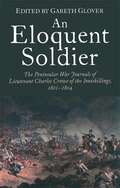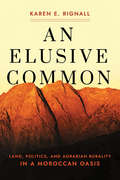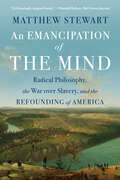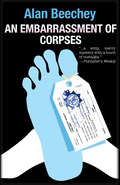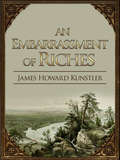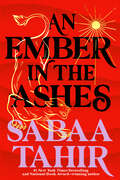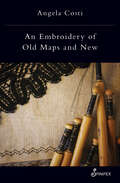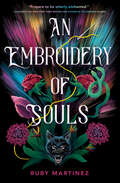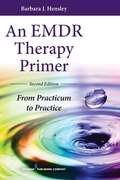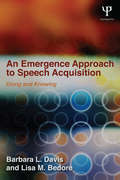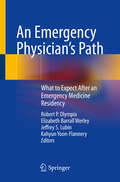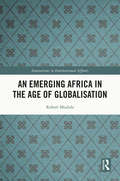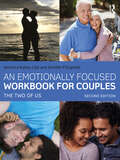- Table View
- List View
An Elm Creek Quilts Companion
by Jennifer ChiaveriniA beautiful keepsake volume to accompany the beloved New York Times bestselling series Over the course of the bestselling Elm Creek Quilts series, readers have expressed a longing to visit Elm Creek Manor, meet the quilters themselves, and admire their beautiful creations. Jennifer Chiaverini’s An Elm Creek Quilts Companion is the next best thing to a guided tour. Inside, readers will discover a treasure trove of delights, including the Bergstrom family tree, character biographies, quilt block illustrations, full-color photographs of quilts featured in the novels, and "Behind the Scenes at Elm Creek Quilt Camp,” an exclusive short story inspired by questions from real readers. No Elm Creek Quilts fan will want to be without this indispensable guide to the cherished series. .
An Eloquent Soldier: The Peninsular War Journals of Lieutenant Charles Crowe of the Inniskillings, 1812-14
by Gareth GloverLieutenant Charles Crowe's journal of the 27th Foot (Inniskillings) of the final campaign of Wellington's army is a rare work for many reasons. It is, perhaps surprisingly, the first memoir about this campaign from this famous regiment to be published.Crowe wrote a daily journal at the time, which practically guarantees the authenticity and accuracy of his account. But what makes it special is that Crowe was extremely well read and was an accomplished writer, so that when he wrote up his journal in 18423, he was able to embellish his basic journal, describing his thoughts, actions and words in beautiful detail. He thus turned his record of his short army career into a masterpiece of journalism. Clearly written purely for the enjoyment of his family, Crowe does not pull his punches: he censures officers both junior and senior; he talks openly of the ravages of war, and the pillaging, raping and looting; the horrors of war, describing the deaths and horrific wounds of many in lurid detail, the cowardice and stupidity; and he also describes the mundane in detail nothing is passed over.Crowe is an invaluable source to military historians on many levels, and his journal will stand proudly deservedly in the pantheon of great military memoirs.
An Elusive Common: Land, Politics, and Agrarian Rurality in a Moroccan Oasis (Cornell Series on Land: New Perspectives on Territory, Development, and Environment)
by Karen E. RignallAn Elusive Common details the fraught dynamics of rural life in the arid periphery of southeastern Morocco. Karen Rignall considers whether agrarian livelihoods can survive in the context of globalized capitalism and proposes a new way of thinking about agrarian practice, politics, and land in North Africa and the Middle East. Her book questions many of the assumptions underlying movements for land and food sovereignty, theories of the commons, and environmental governance. Global market forces, government disinvestment, political marginalization, and climate change are putting unprecedented pressures on contemporary rural life. At the same time, rural peoples are defying their exclusion by forging new economic and political possibilities. In southern Morocco, the vibrancy of rural life was sustained by creative and often contested efforts to sustain communal governance, especially of land, as a basis for agrarian livelihoods and a changing wage labor economy. An Elusive Common follows these diverse strategies ethnographically to show how land became a site for conflicts over community, political authority, and social hierarchy. Rignall makes the provocative argument that land enclosures can be an essential part of communal governance and the fight for autonomy against intrusive state power and historical inequalities.
An Emancipation of the Mind: Radical Philosophy, the War over Slavery, and the Refounding of America
by Matthew Stewart"[A] bracingly original book." —Harold Holzer, Wall Street Journal How a band of antislavery leaders recovered the radical philosophical inspirations of the first American Revolution to defeat the slaveholders’ oligarchy in the Civil War. This is a story about a dangerous idea—one which ignited revolutions in America, France, and Haiti; burst across Europe in the revolutions of 1848; and returned to inflame a new generation of intellectuals to lead the abolition movement—the idea that all men are created equal. In their struggle against the slaveholding oligarchy of their time, America’s antislavery leaders found their way back to the rationalist, secularist, and essentially atheist inspiration for the first American Revolution. Frederick Douglass’s unusual interest in radical German philosophers and Abraham Lincoln’s buried allusions to the same thinkers are but a few of the clues that underlie this propulsive philosophical detective story. With fresh takes on forgotten thinkers like Theodore Parker, the excommunicated Unitarian minister who is the original source of some of Lincoln’s most famous lines, and a feisty band of German refugees, philosopher and historian Matthew Stewart tells a vivid and piercing story of the battle between America’s philosophical radicals and the conservative counterrevolution that swept the American republic in the first decades of its existence and persists in new forms up to the present day. In exposing the role of Christian nationalism and the collusion between northern economic elites and slaveholding oligarchs, An Emancipation of the Mind demands a significant revision in our understanding of the origins and meaning of the struggle over slavery in America—and offers a fresh perspective on struggles between democracy and elite power today.
An Embarrassment of Corpses: An Oliver Swithin Mystery (Oliver Swithin Mysteries #1)
by Alan Beechey"Greenwood fans will welcome her thoughtful second reinterpretation of a well-known Greek myth. Among Greenwood's other talents, she displays a gift for writing songs of the period." —Publishers Weekly STARRED reviewIn this, the third and final book in Kerry Greenwood's Delphic Women series, Greenwood takes us into Troy as it struggles to rise from the ashes of the Trojan War. But while others have told the story as a struggle of men, Greenwood gives this mythology a compelling and exciting female viewpoint.The women of Troy are in terrible transition. Cassandra, the tragic heroine of the second Delphic Woman novel, is King Agamemnon's captive. Queen Clytemnestra has taken a lover who has thrown her own loyalties into question. And then there's Electra, daughter of Clytemnestra and Agamemnon. What compels the young beauty? What secret is she hiding? What are her intentions? Are they dark or justified?Cast aside everything you think you know about the Electra myth and allow yourself to view this classic story from a different perspective. Greenwood's conclusions will surprise and enrapt you.
An Embarrassment of Critch's: Immature Stories From My Grown-Up Life
by Mark CritchThe heartfelt and hilarious story of beloved Canadian comedian Mark Critch's journey from Newfoundland to the national stage--and back home again. One of Mark Critch's earliest acting gigs was in a Newfoundland tourist production alongside a cast of displaced fishery workers. Since, he's found increasing opportunities to take his show on the road. In An Embarrassment of Critch's, the star of CBC's This Hour Has 22 Minutes revisits some of his career's--and the country's--biggest moments, revealing all the things you might not know happened along the way: A wishful rumour spread by Mark's father results in his big break; two bottles of Scotch nearly get him kicked out of a secret Canadian airbase in the United Arab Emirates; and for anyone wondering how to get an interview with the Prime Minister and Bono (yes, that Bono) on the same evening, Critch might recommend a journey to the 2003 Liberal Convention. Critch's top-secret access to all of the funniest behind-the-scenes moments involve many of the charismatic and notorious politicians we love to see blush, including fearless leaders Justin Trudeau, Stephen Harper, Paul Martin, and Jean Chrétien, celebrities such as Pamela Anderson and Robin Williams, and other colourful figures he's met over years of pulling off daring skits at home and abroad. Remember when MP Carolyn Parrish took her boot to George W. Bush Jr.'s head in an interview? Or when Critch asked Justin Trudeau where the best place to smoke pot on Parliament Hill was before pulling out a joint for them to share? There's more to each of those stories than you know. Though Critch has spent years crisscrossing the country--and the globe--with the explicit aim of causing trouble everywhere he goes, like the best journeys, this one takes him right back home.
An Embarrassment of Mangoes: A Caribbean Interlude
by Ann VanderhoofAn Embarrassment of Mangoes is a delicious chronicle of leaving the type-A lifestyle behind -- and discovering the seductive secrets of life in the Caribbean. Who hasn't fantasized about chucking the job, saying goodbye to the rat race, and escaping to some exotic destination in search of sun, sand, and a different way of life? Canadians Ann Vanderhoof and her husband, Steve did just that. In the mid 1990s, they were driven, forty-something professionals who were desperate for a break from their deadline-dominated, career-defined lives. So they quit their jobs, rented out their house, moved onto a 42-foot sailboat called Receta ("recipe," in Spanish), and set sail for the Caribbean on a two-year voyage of culinary and cultural discovery. In lavish detail that will have you packing your swimsuit and dashing for the airport, Vanderhoof describes the sun-drenched landscapes, enchanting characters and mouthwatering tastes that season their new lifestyle. Come along for the ride and be seduced by Caribbean rhythms as she and Steve sip rum with their island neighbors, hike lush rain forests, pull their supper out of the sea, and adapt to life on "island time." Exchanging business clothes for bare feet, they drop anchor in 16 countries -- 47 individual islands -- where they explore secluded beaches and shop lively local markets. Along the way, Ann records the delectable dishes they encounter -- from cracked conch in the Bahamas to curried lobster in Grenada, from Dominican papaya salsa to classic West Indian rum punch -- and incorporates these enticing recipes into the text so that readers can participate in the adventure. Almost as good as making the journey itself, An Embarrassment of Mangoes is an intimate account that conjures all the irresistible beauty and bounty from the Bahamas to Trinidad -- and just may compel you to make a rash decision that will land you in paradise.
An Embarrassment of Mangoes: A Caribbean Interlude
by Ann VanderhoofUnder the Tuscan Sun meets the wide-open sea . . . An Embarrassment of Mangoes is a delicious chronicle of leaving the type-A lifestyle behind -- and discovering the seductive secrets of life in the Caribbean.Who hasn't fantasized about chucking the job, saying goodbye to the rat race, and escaping to some exotic destination in search of sun, sand, and a different way of life? Canadians Ann Vanderhoof and her husband, Steve did just that.In the mid 1990s, they were driven, forty-something professionals who were desperate for a break from their deadline-dominated, career-defined lives. So they quit their jobs, rented out their house, moved onto a 42-foot sailboat called Receta ("recipe," in Spanish), and set sail for the Caribbean on a two-year voyage of culinary and cultural discovery.In lavish detail that will have you packing your swimsuit and dashing for the airport, Vanderhoof describes the sun-drenched landscapes, enchanting characters and mouthwatering tastes that season their new lifestyle. Come along for the ride and be seduced by Caribbean rhythms as she and Steve sip rum with their island neighbors, hike lush rain forests, pull their supper out of the sea, and adapt to life on "island time."Exchanging business clothes for bare feet, they drop anchor in 16 countries -- 47 individual islands -- where they explore secluded beaches and shop lively local markets. Along the way, Ann records the delectable dishes they encounter -- from cracked conch in the Bahamas to curried lobster in Grenada, from Dominican papaya salsa to classic West Indian rum punch -- and incorporates these enticing recipes into the text so that readers can participate in the adventure.Almost as good as making the journey itself, An Embarrassment of Mangoes is an intimate account that conjures all the irresistible beauty and bounty from the Bahamas to Trinidad -- and just may compel you to make a rash decision that will land you in paradise.From the Hardcover edition.
An Embarrassment of Riches
by Alexander GreenTune into the news and you'll hear stories of war, disease, natural disasters, corruption, violence, poverty, crime, nuclear proliferation, terrorism and political dysfunction in Washington. Polls show many believe the American dream is fading, our children face limited opportunities, and the country is decidedly on the wrong track. Yet this dour perspective - one recycled 24/7 by the national media - is a gross distortion of the world we live in today. As national investment expert and bestselling author Alexander Green reveals in this engrossing and provocative new book, the human race has never had it so good. In the West today, we work shorter hours, have more purchasing power, enjoy goods and services in almost limitless supply, and have more leisure time than ever before. Living standards are the highest they have ever been. The human life span has nearly doubled over the past hundred years. Literacy and education levels - even I.Q.'s - are at all-time highs. Technology and medicine are revolutionizing our lives. All forms of pollution - with the exception of greenhouse gases - are in decline. Access to the arts has never been greater. Crime is in a long-term cycle of decline. And the risk of death by violence has never been smaller for most of humanity.By almost every measure, our lives today are wealthy beyond measure. We are all heir to an embarrassment of riches. Yet - thanks in large part the drumbeat of negative media coverage - most of us don't realize it. Green compares the average citizen to "a lottery winner whose ticket is lost in some upstairs drawer."The consequences of adopting the cynical but popular worldview are many, including needless pessimism, missed investment opportunities, and - surprisingly - even poorer health. Yet An Embarrassment of Riches provides a powerful antidote. Green begins with a robust survey of the many ways our lives are becoming longer, easier, safer, healthier and more prosperous. He then embarks on a wide-ranging exploration of the ideas and the many men and women - both living and dead - that are still enriching our lives today.Among the many subjects explored are American exceptionalism, the extraordinary power of economic freedom, the lifesaving role of medicine and technology, the life-extending benefits of optimism, the radical theology of Thomas Jefferson, the keys to civility and greatness, the wisdom of Confucius and Aristotle, the ability of beauty to enrich our lives, and even one artist's thought-provoking take on "how to defeat death."In An Embarrassment of Riches, New York Times bestselling author Alexander Green offers a holistic approach to wealth - and offers a welcome perspective that allows us to live fuller, richer lives.
An Embarrassment of Riches
by James Howard KunstlerA picaresque novel of the American West in 1803. An historical comedy about two bumbling botanists sent into the southern wilderness by Thomas Jefferson to look for something that isn't there. A novel in the spirit of Lewis and Clark (who make cameo appearences). Replete with wild Indians, river pirates, the kidnapped son of King Louis XVI, the lost colony of Roanoke, and much more. A non-stop romp full of life and humor and the sensibility of early America.
An Ember in the Ashes (An Ember in the Ashes #1)
by Sabaa TahirBOOK ONE IN THE NEW YORK TIMES BESTSELLING SERIES • One of Time Magazine&’s 100 Best Fantasy and 100 Best YA Books of All Time • People's Choice Award winner • Bustle's Best Young Adult Book &“This novel is a harrowing, haunting reminder of what it means to be human—and how hope might be kindled in the midst of oppression and fear.&” — The Washington Post The beloved and bestselling fantasy series that &“glows, burns, and smolders.&” (Huffington Post). Laia is a slave. Elias is a soldier. Neither is free. Under the Martial Empire, defiance is met with death. Those who do not vow their blood and bodies to the Emperor risk the execution of their loved ones and the destruction of all they hold dear. It is in this brutal world, inspired by ancient Rome, that Laia lives with her grandparents and older brother. The family ekes out an existence in the Empire&’s impoverished backstreets. They do not challenge the Empire. They&’ve seen what happens to those who do. But when Laia&’s brother is arrested for treason, Laia is forced to make a decision. In exchange for help from rebels who promise to rescue her brother, she will risk her life to spy for them from within the Empire&’s greatest military academy. There, Laia meets Elias, the school&’s finest soldier—and secretly, its most unwilling. Elias wants only to be free of the tyranny he&’s being trained to enforce. He and Laia will soon realize that their destinies are intertwined—and that their choices will change the fate of the Empire itself. ONE OF THE BEST BOOKS OF THE YEAR FROM The Wall Street Journal • Buzzfeed • LA Weekly • Bustle • Paste Magazine • Indigo • Suspense Magazine • The New York Public Library • Popsugar • Hypable
An Embroidery of Old Maps and New
by Angela CostiI can see how I carry Yiayia's war in the ample dunes of my belly, the moment she smelt the guns, she pinched the candle's wick,gathered the startled shadows of her children,flung my baby-mother onto her backand sprinted towards the neutral moon—Migration and the memories of women's traditions are woven throughout these poems. Angela Costi brings the world of Cyprus to Australia. Her mother encounters animosity on Melbourne's trams as Angela learns to thread words in ways that echo her grandmother's embroidery. Here are poems that sing their way across the seas and map histories.
An Embroidery of Souls
by Ruby MartinezJade can manipulate souls with the tug of a thread—it&’s up to her, and a boy with a soul as bright as the universe to stop a creature on the loose before it claims its next victim in this lush, Mexican & German inspired romantasy. "Richly woven with magic, intrigue, and romance. Prepare to be utterly enchanted."—Elizabeth Lim, New York Times bestselling author of Six Crimson CranesJade Aguilar can stitch beauty and brilliance into existence—unravel life itself. Like her mother, she&’s a thread speaker in the queendom of Mérecal, where their rare gift can be used only in service of the Crown. When her mother, the master thread speaker, goes missing amid a spree of unusual deaths, the queen orders Jade to find her or be conscripted into a life of servitude. Lukas Keller, a boy with a heart as bright as the universe, is desperate to save his family from the clutches of poverty. He gets caught up with a vicious gang and is forced to do the one thing he swore he would never do: seek the help of a thread speaker. Jade and Lukas form a mistrustful alliance. As Mérecal descends into chaos, it&’s clear there is something monstrous on the hunt. Jade and Lukas cling to each other for survival—and perhaps . . . something more. In her spellbinding debut, Ruby Martinez weaves a wildly romantic, heart-pounding mystery set against the backdrop of Mexican and German lore.
An Emdr Therapy Primer: From Practicum To Practice
by Barbara J. HensleyThis is a step-by-step overview of the foundations of EMDR Therapy presented in easily accessible, conversational language. It helps both new and experienced clinicians to maximize their preparation and skills in using EMDR safely, confidently, and effectively. The second edition is fully revised to reflect the evolution of EMDR to an integrative psychotherapeutic approach and is intended for use as a companion to Francine Shapiro's seminal EMDR texts. It has been enriched with several new case histories along with extensive examples of successful EMDR reprocessing sessions. An abundance of new information addresses EMD versus EMDR; research on the mechanism, model, and methodology of EMDR Therapy; bilateral stimulation; ancillary targets; the why and the how of many key EMDR Therapy components; protocol for single and recent traumatic events; updated information about the cognitive interweave, future templates; and much, much more. The book provides concise coverage of the AIP model and EMDR principles, protocols, and procedures and addresses the types of targets accessed during the EMDR process. The book summarizes the Eight Phases of EMDR Therapy and the Stepping Stones of Adaptive Resolution the components of the standard EMDR protocol. The building blocks of EMDR Therapy past, present, and future are assessed with regard to appropriate targeting and successful outcomes, as are abreactions, blocked processing, and cognitive interweaves. Detailed case studies demonstrate strategies to assist the client in reaching adaptive resolution of trauma.
An Emergence Approach to Speech Acquisition: Doing and Knowing
by Barbara L. Davis Lisa M. BedoreThe central assertion in this volume is that the young child uses general skills, scaffolded by adults, to acquire the complex knowledge of sound patterns and the goal-directed behaviors for communicating ideas through language and producing speech. A child’s acquisition of phonology is seen as a product of her physical and social interaction capacities supported by input from adult models about ambient language sound patterns. Acquisition of phonological knowledge and behavior is a product of this function-oriented complex system. No pre-existing mental knowledge base is necessary for acquiring phonology in this view. Importantly, the child’s diverse abilities are used for many other functions as well as phonological acquisition. Throughout, an evaluation is made of the research on patterns of typical development across languages in monolingual and bilingual children and children with speech impairments affecting various aspects of their developing complex system. Also considered is the status of available theoretical perspectives on phonological acquisition relative to an emergence proposal, and contributions that this perspective could make to more comprehensive modeling of the nature of phonological acquisition are proposed. The volume will be of interest to cognitive psychologists, linguistics, and speech pathologists.
An Emergency Physician’s Path: What to Expect After an Emergency Medicine Residency
by Kahyun Yoon-Flannery Robert P. Olympia Jeffrey S. Lubin Elizabeth Barrall WerleyA career in emergency medicine can be truly rewarding, despite the long hours and adverse conditions. The decision to embark on this journey typically starts during medical school, usually with the allure of resuscitations and life-saving procedures performed in the fast-paced environment of the emergency department. During an emergency medicine residency, the young physician is faced with career decisions that may involve working in a community or academic emergency department setting, or pursuing specialization through fellowship. Following residency and fellowship training, the emergency physician may decide to purely work clinically in an emergency department, or combine clinical responsibilities with administrative, education or research pursuits. This unique text provides medical students, residents, fellows and attending physicians with a comprehensive guide to be successful in a career in emergency medicine. Sections include the history of emergencymedicine, choosing a career in emergency medicine from a medical student’s point of view, pursuing fellowship and additional training, community and academic careers in emergency medicine, career options in emergency medicine, critical skills in emergency medicine, research/scholarship, being a teacher, and carving a path in emergency medicine. All chapters are written by experts in the field, representing emergency departments throughout North America.
An Emergent Curriculum for the Early Years in Malta: Stories of Professional and Pedagogical Transformation (Routledge Research in Early Childhood Education)
by Carmen Dalli Charmaine Bonello Anna BaldacchinoThis book charts the firsthand experiences and challenges faced by Maltese early childhood educators in the implementation of a novel approach to the curriculum: the replacement of a prescriptive curricula with one co-constructed by the educator and the child.Chapters provide seven contextualised, inspiring narratives of how the ‘emergent curriculum’ approach was implemented, received, and reflected upon within Maltese educational settings, ranging from childcare (0–3 years), kindergarten (3–5 years), and early primary (5–7 years). Packed with practical guidance along with on-the-ground commentary, this volume showcases the pedagogical and professional transformation of these educators, informing and encouraging reflection as well as inspiring others on a global scale. Challenging the established modes and traditions of pedagogical best practice, this book ultimately fills a gap in research on how educators in diverse local contexts and cultures can embrace the global concept of the ‘emergent curriculum’ within their own practice and settings.Providing pedagogical and professional insights for early years educators in similar contexts internationally, the book will be of interest to researchers and early childhood educators, as well as curriculum designers and policy makers interested in how the curriculum can take shape in different cultures and contexts.
An Emerging Africa in the Age of Globalisation (Innovations in International Affairs)
by Robert MudidaSince the turn of the century, Africa has been emerging economically, politically and socially, and striving to assert itself on the global stage. This book provides an interdisciplinary view of Africa’s struggle to find its unique voice and contribute to the dialogue of international affairs. Highlighting both challenges and opportunities, the book explores the multi-faceted economic, political and social debates that surround Africa’s emergence in a complex, increasingly globalised world. The author provides holistic, complementary and policy-oriented advice to African governments and policymakers on how to cope with new interrelated realities in an age of globalisation. This book will be of great interest to students, academics and researchers in the areas of political economy, international development, global governance, public policy and the international relations of African states. It will also appeal to African leaders, policymakers and governments who seek to increase the ability of their countries to cope with the challenges presented by a globalised world.
An Emerging Approach for Education and Care: Implementing a Worldwide Classification of Functioning and Disability
by Susana Castro Olympia PalikaraAn Emerging Approach for Education and Care provides a synthesis of the extensive research that has been conducted worldwide about the International Classification of Functioning, Disability and Health for Children and Youth in education and care. The main purpose of the ICF is to provide a classification of functioning for adults and children with difficulties, considering their everyday lives, all the activities they perform and the environments they are embedded in, in addition to their health condition, which has been the traditional focus of Special Education provision in many countries. Each chapter presents an evidence-based study describing how the ICF has been used to improve the provision of services for children and young people with Special Educational Needs around the world. Moreover, each chapter is written by an expert on the ICF from a different country, thus providing an overview of how the ICF can be applied in international educational contexts with different educational and health systems and cultural backgrounds. This synthesis of world-leading research focuses on the ICF as a framework to approach assessment, intervention and classification for children and young people with SEN, whilst also providing practical examples of how it can be implemented. An Emerging Approach for Education and Care will be essential reading for academics, researchers and practitioners working on Special Educational Needs provision and rehabilitation. It should also be of great interest to those involved in the study of early childhood education, and for postgraduate students aspiring to work in these settings.
An Emerging Non-Regular Labour Force in Japan: The Dignity of Dispatched Workers (Nissan Institute/Routledge Japanese Studies)
by Huiyan FuLike many industrialised nations, the current employment trend in Japan centres on diversification of the labour market with an increased use of temporary labour. Among a wide range of non-regular labour arrangements, haken are a newly legalised category of non-regular workers who are typically employed by the employment agency while working at the facilities of and being under the authority of the client firm. They have recently expanded exponentially under the state’s deregulation policy and assumed considerable significance in political debate, especially with regard to the nation’s ‘widening gaps’ known as kakusa. This is the first anthropological study of haken and temporary agency work (TAW) in Japan which combines both macro- and micro level analyses. At the macro level, haken are explored from a historical perspective with a view to showing the changing state policy and public perception of haken. At the micro level, how TAW is experienced by real people in concrete situations is extremely varied and complex, often depending on intersecting structural variables including gender, age and class. The book therefore provides insight into the gap between powerful discourses and everyday life, as well as a better understanding of personhood in Japan’s shifting landscape of employment. This book will be of interest to students and scholars of Japanese Studies, Japanese Business, Asian Business and Asian Anthropology.
An Emotion of Great Delight
by Tahereh MafiFrom bestselling and National Book Award–nominated author Tahereh Mafi comes a stunning novel about love and loneliness, navigating the hyphen of dual identity, and reclaiming your right to joy—even when you’re trapped in the amber of sorrow. It’s 2003, several months since the US officially declared war on Iraq, and the American political world has evolved. Tensions are high, hate crimes are on the rise, FBI agents are infiltrating local mosques, and the Muslim community is harassed and targeted more than ever. Shadi, who wears hijab, keeps her head down. She's too busy drowning in her own troubles to find the time to deal with bigots. Shadi is named for joy, but she’s haunted by sorrow. Her brother is dead, her father is dying, her mother is falling apart, and her best friend has mysteriously dropped out of her life. And then, of course, there’s the small matter of her heart— It’s broken. Shadi tries to navigate her crumbling world by soldiering through, saying nothing. She devours her own pain, each day retreating farther and farther inside herself until finally, one day, everything changes. She explodes. An Emotion of Great Delight is a searing look into the world of a single Muslim family in the wake of 9/11. It’s about a child of immigrants forging a blurry identity, falling in love, and finding hope—in the midst of a modern war.
An Emotional State: The Politics Of Emotion In Postwar West German Culture
by Anna M. ParkinsonThis literary-historical study seeks to dismantle the prevailing notion that Germany, in the period following the Second World War, exhibited an "inability to mourn," arguing that in fact the period experienced a surge of affect. Anna Parkinson examines the emotions explicitly manifested or addressed in a variety of German cultural artifacts, while also identifying previously unacknowledged (and under-theorized) affective structures implicitly at work during the country's national crisis. Much of the scholarship in the expanding field of affect theory distrusts Freudian psychoanalysis, which does not differentiate between emotion and affect. One of the book's major contributions is that it offers an analytical distinction between emotion and affect, finding a compelling way to talk about affect and emotion that is informed by affect theory but that integrates psychoanalysis. The study draws on the psychoanalytic writings of Freud, Margarete and Alexander Mitscherlich, and André Green, while engaging with interdisciplinary theorists of affect including Barbara Rosenwein, Lauren Berlant, Ann Cvetkovich, and Eve Kosofsky Sedgwick, among many others.
An Emotionally Focused Guide to Relationship Loss: Life After Love
by Clare RosomanBy viewing romantic love as an attachment bond, Clare Rosoman incorporates emotionally focused therapy (EFT) and attachment theory to provide evidence-based tools in navigating close relationships and managing the pain of relationship loss. Beginning with a foreword from Veronica Kallos-Lilly, this book firstly explores how attachment themes show up in relationship dynamics, creating either security or insecurity, before looking at how relationships go wrong. Chapters then focus on creating a new narrative for this loss of connection, helping readers learn about their own attachment strategies and how to work through pain, anger, and grief. The last part focuses on helping readers learn how to forgive, let go, build security within themselves, and implement these strategies in future relationships. Addressing all forms of relationships, including family and friendship losses, LGBTQ+ couples, and references to cultural humility, this accessible and empathetic guide is written for both therapists and their clients to help them learn from their experiences and build the ability to be a resource for themselves. It is essential reading for EFT therapists as well as couple, marriage, and family therapists.
An Emotionally Focused Workbook for Couples: The Two of Us
by Veronica Kallos-Lilly Jennifer FitzgeraldThis workbook is intended for use with couples who want to enhance their emotional connection or overcome their relationship distress. It is recommended for use with couples pursuing Emotionally Focused Therapy (EFT). It closely follows the course of treatment and is designed so that clinicians can easily integrate guided reading and reflections into the therapeutic process. The material is presented in a recurring format: Read, Reflect, and Discuss. Readings help couples look at their relationship through an attachment lens, walking them through the step-by-step process of creating a secure relationship bond. 33 Reflections invite readers to engage with the material personally, expanding their own awareness and ability to tune into their partner. Discussion sections suggest relationship-building exercises and a framework for conversations that promote safety, disclosure, and engagement. Case examples, along with informative illustrations, are scattered throughout the book to validate, illustrate, and inspire couples along their journey. Clinicians conversant with EFT can use this workbook to extend the effectiveness of their work with couples by giving them structured tasks to work on between sessions. For clinicians training in EFT, the book can guide them in staying focused on the EFT roadmap and illuminate how important change events unfold.
An Emotionally Focused Workbook for Couples: The Two of Us
by Veronica Kallos-Lilly Jennifer FitzgeraldThe second edition of this essential and newly updated workbook is intended for use with couples who want to enhance their emotional connection or overcome their relationship distress. It closely follows the course of EFT treatment and allows clinicians to easily integrate guided reading, reflection, and discussion into the therapeutic process. Incorporating new developments in EFT and decades of research in the field of attachment, Veronica Kallos-Lilly and Jennifer Fitzgerald include chapters that explore concepts such as attachment bonds, the three cycles of relationship distress, how to make sense of emotions, relationship hurts and more. The workbook follows the familiar and accessible format of the first edition, Read, Reflect, and Discuss, and weaves fresh, illustrative examples throughout, with updated content considering the impact of gender, culture, and sexual orientation on relationship dynamics. Added reflections on these topics and an expanded section on sexuality dispels constraining popular myths and frees partners up to express themselves more openly. This book is essential reading for partners looking for helpful steps to improve the quality of their romantic relationships as well as marriage and family therapists, couple therapists and clinicians training in EFT to use with their clients.

